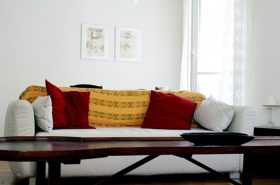This is a post that I have been thinking about for a long time but I was spurred on by my friend’s cry for help the other week to actually sit down and finish it. I don’t want to be all oh in my day we were happy with a cardboard box but I will state that now more than ever before we are spoiled for choice when it comes for children’s products. It took a long while for designers and marketers to understand that people will fork out a lot of money on their children. Even when you say you won’t and even when you don’t have the money to spend, why because it is an emotional time being a parent and analyzing that is a post in itself. So today I will just help you navigate through the design process and hopefully help you save some cash by not making mistakes.
Designing a room for a child is just as much of a lifestyle decision as any other room in the house. The way that their space is arranged can effect how they play, the time you have to spend with them and the way they sleep so it is vital that we get it right.
1. Don’t focus on the room as a nursery.
It is very easy to think of the the room as this place where you will be sitting on a rocking chair feeding your baby and dreamily looking out of the window but that stage of baby is very short lived and they will more than likely sleep in your room for most of it. Of course it is every parents decision on whether they have their baby in the same room or not so here is a link to research and advice on the subject. Regardless of where your baby sleeps they will be using their room for more than sleep faster than you think so don’t waste so much money on anything that cannot translate to a toddler room. Toys and ornaments that they will point to and ask for may be dangerous or destroyed are probably best not to put in their room in the first place. The image above shows a beautiful room but one that will be outgrown within a year.
2. Kneel down or squat.
Think about the eye line of your child, the room is for them after all. Think about areas of interest and try to delineate the space. Children are small and they like to crawl into spaces and have different areas. You don’t have to have a huge space in order to create other areas, remember these guys are small. The room above is beautiful and colourful but most things are out of reach and will encourage unsafe climbing. Children need to see their things.
3. Ban the toy box.
The toy box is an awful way to store toys. It might be an easy option at the end of a day to shove everything in at the end of the day but a toy box does not promote play and toys get broken and mixed up in there. When children play they want to be able to access their things instead of looking for something for ages, (with your help), only to discover that they cannot find part of the toy or it is broken, then you have to deal with that fall out. Display toys and move them around and encourage tidy up time and your children will take more care and play more effectively. There are a lot of fun ways to display and tidy their toys.
4. Combine style & substance.
I like every other parent have perused stunning pictures of children’s rooms on Pinterest. I too have thought look at those lovely white washed floors but stop and think back to my first point, they are babies for a very short time. Those hardwood floors are not great for a crawling baby or one that is starting to walk, and as they get older and you are crawling about on that floor playing with them you will wish you went for a carpet. And yes we still have messy play, the really messy stuff happens in the kitchen.
Questions of style and substance will happen that go beyond flooring choices, curtains that pool on the floor are great in the lounge and not practical for kiddos. Keeping in mind safety and comfort does not mean that your room is not stylish.
5. Design a space that can grow BUT REMEMBER THEY ARE CHILDREN.
Often a parent will go berserk with a particular theme or whim of their little one. Then after changing this once or twice they snap and give them a bland teenager style room at the tender age of 8. I get that it can feel frustrating and I completely understand why a child is then pushed towards a very grown up space but they are only young once. Designing your child’s room is the closest you will get to being a real life interior designer, (unless you are in fact an interior designer). It is your role to take their ideas and interpret their design. You can take a theme or idea and give it a real modern twist and that helps the room grow with them and that way it will last longer.
Room design is a lifestyle choice and I am very anti TV in the bedroom, any bedroom! Having a TV in a room is divisive to family life in my opinion and staring at blue light does not promote sleep.
6. Use the room shape to create play spaces.
Children like to have spaces that are delinted. Small spaces to crawl into and explore. Remember standing in a huge playground at school and being told to play, the space was a little overwhelming right? If you don’t have alcoves and corners you can exploit in your little ones room think about how you can do the same with furniture.














